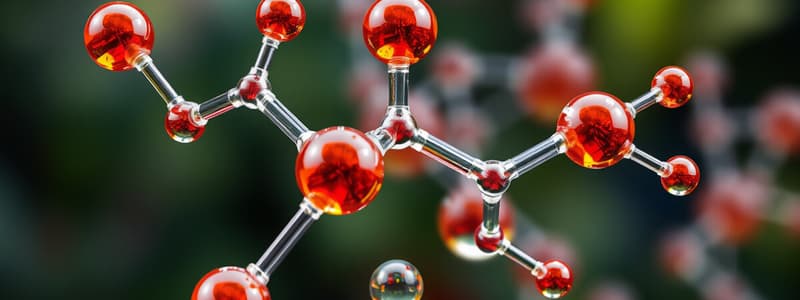Podcast
Questions and Answers
What is the primary focus of organic chemistry?
What is the primary focus of organic chemistry?
The primary focus of organic chemistry is the study of carbon-containing compounds and their properties.
Explain the difference between structural isomers and stereoisomers.
Explain the difference between structural isomers and stereoisomers.
Structural isomers have the same formula but different structures, while stereoisomers have the same structural formula but differ in the spatial arrangement of atoms.
Define thermodynamics in the context of physical chemistry.
Define thermodynamics in the context of physical chemistry.
Thermodynamics is the study of energy changes during chemical reactions, including the laws governing these changes.
Describe the role of ligands in coordination compounds.
Describe the role of ligands in coordination compounds.
What characterizes a chemical equilibrium?
What characterizes a chemical equilibrium?
How do Bronsted-Lowry acids and bases differ from the Arrhenius definition?
How do Bronsted-Lowry acids and bases differ from the Arrhenius definition?
What is the significance of rate laws in chemical kinetics?
What is the significance of rate laws in chemical kinetics?
Identify a common type of reaction in organic chemistry and briefly describe it.
Identify a common type of reaction in organic chemistry and briefly describe it.
Flashcards
Organic Chemistry
Organic Chemistry
The study of carbon-containing compounds and their properties.
Functional Groups
Functional Groups
Specific groups of atoms within molecules that dictate the molecule's characteristics and reactivity.
Isomers
Isomers
Compounds that have the same molecular formula but different structural formulas.
Addition Reaction
Addition Reaction
Signup and view all the flashcards
Substitution Reaction
Substitution Reaction
Signup and view all the flashcards
Inorganic Chemistry
Inorganic Chemistry
Signup and view all the flashcards
Salts
Salts
Signup and view all the flashcards
Thermodynamics
Thermodynamics
Signup and view all the flashcards
Study Notes
Organic Chemistry
- Definition: The study of carbon-containing compounds and their properties.
- Key Concepts:
- Functional Groups: Specific groupings of atoms within molecules that determine characteristics and reactivity.
- Examples: Hydroxyl (-OH), Carboxyl (-COOH), Amino (-NH2).
- Isomerism: Compounds with the same formula but different structures.
- Types: Structural isomers, stereoisomers (geometric and optical isomers).
- Reactions:
- Addition reactions: Atoms are added to a double bond.
- Substitution reactions: An atom or group is replaced by another atom or group.
- Elimination reactions: Atoms are removed to form a double bond.
- Functional Groups: Specific groupings of atoms within molecules that determine characteristics and reactivity.
Inorganic Chemistry
- Definition: The study of inorganic compounds, which include metals, minerals, and organometallic compounds.
- Key Concepts:
- Types of Compounds:
- Salts: Formed from the reaction of an acid and a base.
- Coordination compounds: Complexes that involve a central metal atom bonded to surrounding ligands.
- Periodic Table: Understanding trends such as electronegativity, atomic radius, and ionization energy.
- Acids and Bases:
- Arrhenius definition: Acids produce H+ ions; bases produce OH- ions.
- Bronsted-Lowry definition: Acids donate protons; bases accept protons.
- Types of Compounds:
Physical Chemistry
- Definition: The study of how matter behaves on a molecular and atomic level and how chemical reactions occur.
- Key Concepts:
- Thermodynamics: The study of energy changes during chemical reactions.
- Laws of thermodynamics: Conservation of energy, entropy, and absolute zero.
- Kinetics: The study of reaction rates and the factors that affect them.
- Rate laws: Mathematical expressions relating reaction rate to reactant concentrations.
- Quantum Chemistry: Explores the quantum mechanical behavior of atoms and molecules.
- Key principles: Wave-particle duality, uncertainty principle, and electron configurations.
- Chemical Equilibrium: The state in which the rates of forward and reverse reactions are equal, and concentrations remain constant.
- Thermodynamics: The study of energy changes during chemical reactions.
Conclusion
- Understanding the distinct areas of chemistry allows for a comprehensive study of matter and its interactions.
- Each subfield plays a crucial role in the broader understanding of chemical principles and applications.
Organic Chemistry
- Study of carbon-containing compounds and their properties.
- Functional Groups: Critical for determining characteristics and reactivity of organic molecules.
- Examples include Hydroxyl (-OH), Carboxyl (-COOH), and Amino (-NH2).
- Isomerism: Compounds with identical formulas may have varying structures.
- Includes structural isomers and stereoisomers (geometric and optical).
- Types of Reactions:
- Addition reactions involve adding atoms to a double bond.
- Substitution reactions replace one atom/group with another.
- Elimination reactions result in the removal of atoms, forming double bonds.
Inorganic Chemistry
- Focuses on inorganic compounds like metals, minerals, and organometallics.
- Types of Compounds:
- Salts are produced from acid-base reactions.
- Coordination compounds feature a central metal atom bonded to ligands.
- Knowledge of the Periodic Table informs on trends such as electronegativity, atomic radius, and ionization energy.
- Acids and Bases:
- Arrhenius definition classifies acids as producers of H+ ions and bases as OH- ions.
- Bronsted-Lowry definition describes acids as proton donors and bases as proton acceptors.
Physical Chemistry
- Examines matter's behavior at molecular and atomic levels and the nature of chemical reactions.
- Thermodynamics: Investigates energy changes during reactions guided by the laws of energy conservation, entropy, and absolute zero.
- Kinetics: Analyzes reaction rates and influencing factors.
- Rate laws express the relationship between reaction rates and reactant concentrations.
- Quantum Chemistry: Discusses the quantum mechanics governing atomic and molecular behavior.
- Key concepts include wave-particle duality, the uncertainty principle, and electron configurations.
- Chemical Equilibrium: Represents a state where forward and reverse reaction rates equalize, maintaining constant concentrations.
Conclusion
- Each chemistry subfield contributes uniquely to a comprehensive understanding of matter and its interactions, emphasizing the importance of integrating knowledge across disciplines.
Studying That Suits You
Use AI to generate personalized quizzes and flashcards to suit your learning preferences.




